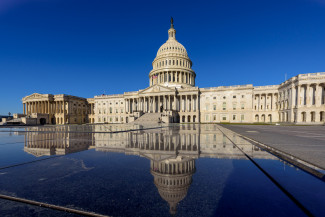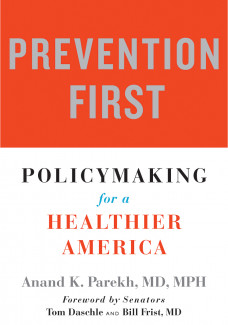
Johns Hopkins UniversityEst. 1876
America’s First Research University
Prevention First: Policymaking for a Healthier America

The central theme in Prevention First: Policymaking for a Healthier America is that policymakers must place disease prevention at the center of our nation’s health policy. This is critical to improving the health of the United States – which is declining relative to other comparable peer countries around the world – and enhancing our economic outlook, military readiness, and cohesiveness as a nation.
Early in my career as a physician, I found myself mostly caring for patients with multiple concurrent chronic conditions. Improving the quality of life and health status of these medically complex patients subsequently became a key policy focus area of mine while I served at the U.S. Department of Health and Human Services. Somewhere along the away, I came to the realization that most of the conditions I had been treating could have been prevented in the first place. To a certain extent, we had been failing our patients as well as the public by not partnering with them to forestall diseases in the first place. Our health care system was really a “sick care” system, and our health policies were really “sick care” policies. I knew if we were to have any chance as a population to improve health outcomes and reduce preventable health care costs, then this had to change. What we need is to build a culture of prevention.
This message is especially timely given that the United States is experiencing the first three-year decline in life expectancy in over 100 years – since World War I and the 1918 Spanish Flu. The reasons for this include a host of preventable challenges including the opioid epidemic, the obesity crisis, and the plateauing of the decline in mortality from cardiovascular disease and cancer. The Centers for Disease Control and Prevention has estimated that nearly 250,000 Americans die potentially preventable deaths annually from the five leading causes of death – heart disease, cancer, stroke, chronic lower respiratory disease, and unintentional injury.
Fortunately, there is a plethora of evidence-based prevention interventions, based both within and outside the health care sector, which can reduce preventable deaths in this country. This includes practices which can avert disease such as immunizations, motor vehicle safety, and healthy behavior counseling; detect disease for early intervention such as cancer screenings; and mitigate disease such as chronic disease self-management programs. While personal responsibility for eating well, being physically active, maintaining a healthy weight, drinking alcohol in moderation, and not smoking is integral, this must be paired with policies, systems, and environmental changes to make the healthy choice the easy choice, or the default choice.

Building a culture of prevention is the shared responsibility of individuals, families, communities, faith-based organizations, schools, workplaces, the media, and as this book makes clear, policymakers. Prevention First makes five overarching recommendations to policymakers: 1) Current and future administrations must make prevention the number one priority as manifested in its strategic planning efforts and budget submissions to Congress. 2) Consistent with value-based health care transformation, health care professionals should be incentivized and accountable for preventing chronic diseases. 3) A regulatory pathway should be created to expand and scale evidence-based community prevention programs. 4) Targeted investments should be made in this country to support community prevention efforts, the public health infrastructure, and a public health emergency fund. 5) The nation’s health research enterprise must increase prevention research, spanning biology, behavior change, and policy implementation.
Placing prevention first will not come easy. Policymakers seem to be facing constant crises, whether it’s a health emergency or a political controversy, and the default mode in government is often reactive. Disease prevention demands being proactive and is thus often cast aside to deal with more “urgent” policy issues. In addition, measurable results in the prevention area often require time (as opposed to “quick wins”) and even then are often “invisible,” in the sense that they are averting disease. Beyond this, policymakers may not fully grasp the evidence-base behind the science of prevention, may associate government intervention with a “nanny state,” and may find it difficult to appropriate additional resources in this fiscal climate.
While all of these reasons explain why a ‘Prevention First’ orientation to health in America may be challenging, they are not insurmountable obstacles. And the reason I am optimistic is that, as detailed in this book, there are people all across this country leading the way by putting prevention into practice each and every day. We must make sure their efforts are not only well-publicized, supported, shared, and scaled, but we must also communicate to them that their work in disease prevention is indeed among the most important activities to improve the nation’s health. What this book is about, they already know. It’s time for the rest of us, including policymakers and healthcare leaders, to catch up. Prevention must be first.
Order Prevention First: Policymaking for a Healthier America – published on December 3, 2019 – at the following link: https://jhupbooks.press.jhu.edu/title/prevention-first
Anand K. Parekh, MD, MPH, a board-certified internal medicine physician, is the chief medical advisor at the Bipartisan Policy Center. Previously, he completed a decade of service at the US Department of Health and Human Services. As a deputy assistant secretary for health from 2008 to 2015, he developed and implemented national initiatives focused on prevention, wellness, and care management. Dr. Parekh is the author of Prevention First: Policymaking for a Healthier America.



